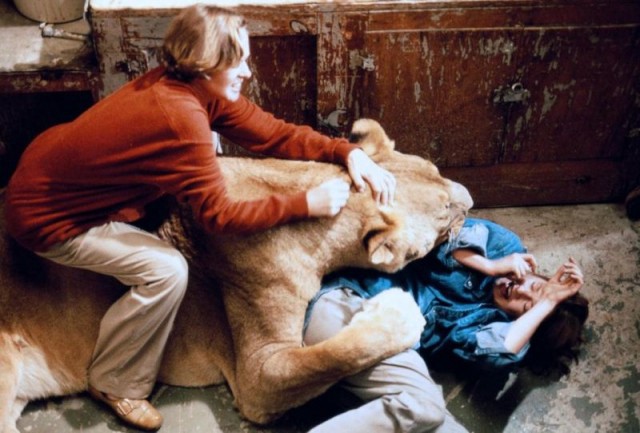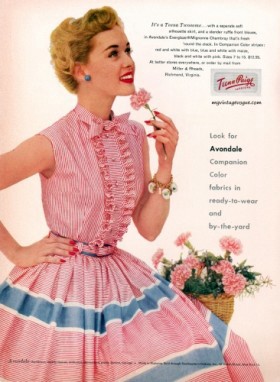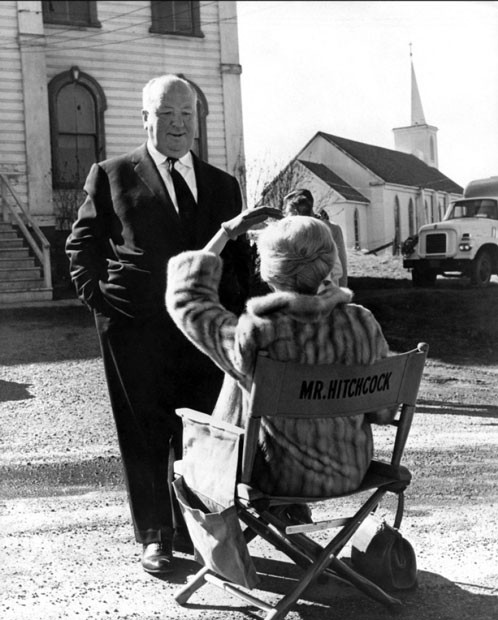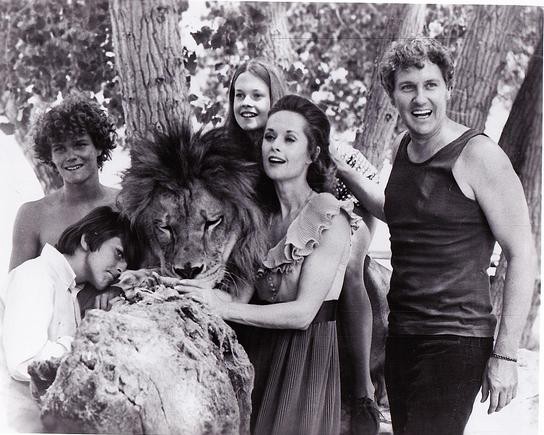How To Get Your Lion Back When It Runs Away: Life Lessons From Tippi Hedren

Tippi Hedren and Melanie Griffith on the set of Roar.
Of course you know Tippi Hedren from The Birds. Less likely is that you’ve seen another movie she was in called Roar. It came out in 1981 and starred Hedren along with her then-husband, two of her stepsons and her daughter Melanie Griffith. (A third stepson worked behind the scenes.) It was a complete family production, filmed at their canyon ranch in Acton, out toward the desert from Burbank and Chatsworth. In addition to playing the lead role, Hedren’s husband, Noel Marshall, acted as the movie’s writer, producer and director. Hedren shopped for the movie’s wardrobe. She also operated a backhoe on the set. When it was fall, one of the stepsons climbed a ladder to spray-paint the leaves of the trees green again.
Roar’s working title was Lions, Lions and More Lions, and that’s a fair summary what the movie’s about: Lions, lions and more lions, and tigers, and then, as long as we’re here, why not some jaguars and cheetahs and cougars and leopards, too? There’s some pretense at a plot — a scientist is making a study of big cats in Africa; his family comes for a visit; he’s not home when they arrive and so they run from room to room and up and down stairs under the threat of the lions, lions and more lions until he comes home; poachers encroach — but really, it doesn’t matter. If you’ve seen Roar, it’s because you’re a fan of big cats and movies about big cats, or because you’re a Hedren-Griffith completist and get a thrill from hearing Tippi utter a suburban movie-mom line like “Help your sister” to a teenage boy as Melanie is being dragged off by a 400-pound lion. (Or you’re a Hitchcock completist and enjoy imagining how The Birds might have been different had the director been an enthusiastic birder and done his movie as Crows, Crows and More Crows.)
Roar is a mess. A big, exuberant mess, and it was a nearly ruinous one. It took over a decade to make, cost $17 million to film, and only grossed $2 million. During the filming, four members of the family were seriously injured, including Hedren and Griffith: Hedren was bitten in the back of the neck by a lion, and Griffith clawed in the face. The director of cinematography, Jan de Bont, was effectively scalped when a lion’s bite tore off the top of his head.
After filming was completed, the question remained of what to do with the 150 cat actors assembled for the movie and now living at the ranch. Who would provide for them?
Hedren would — and the property became the nonprofit Shambala Preserve. This is where Tippi, now 82, still lives, along with some 50 big cats and other exotic animals. In addition to its lobbying work on a bill to protect exotic animals from being kept as pets, the sanctuary offers tours, including — and here I’m just pointing out something that you might wish to do some weekend when you have an extra three grand lying around — overnight tent stays where you can enjoy appetizers with “your gracious hostess Tippi Hedren” (schedule permitting) (but still!) followed by “a salad, a gourmet dinner, and a dessert.” I assume “a beverage,” also.
And so the actress famously terrorized by birds on screen has, in her post-Hitchcock life, surrounded herself with cats, cats and more cats. How does that happen, though? How do you end up with 50 lions and tigers living outside your door? For that matter, how do you end up with one lion?
BACK IN YOUR GILDED CAGE
“A bird ran into my giant freak-head.”
Can I interest you in a highly selective, highly gossip-y and highly fairy-tale-inflected take on Hedren’s work with Hitchcock? Because it interests me that he was so possessive of her off-screen (to borrow a word that crops up in different accounts of their relationship) and that in both the films she made with him, The Birds and Marnie, the characters she played end up in a series of cages and traps, until, finally broken of their wildness, they can’t run anymore.
In one of the conversations he had with François Truffaut, Hitchcock described a couple of the cages in The Birds:
At the beginning of the film we show Rod Taylor in the bird shop. He catches the canary that has escaped from its cage, and after putting it back, he says to Tippi Hedren, “I’m putting you back in your gilded cage, Melanie Daniels.” I added that sentence during the shooting because I felt it added to her characterization as a wealthy, shallow playgirl. And later on, when the gulls attack the village, Melanie Daniels takes refuge in a glass telephone booth and I show her as a bird in a cage. This time it isn’t a gilded cage, but a cage of misery, and it’s also the beginning of her ordeal by fire, so to speak. It’s a reversal of the age-old conflict between men and birds. Here the human beings are in cages and the birds are on the outside. When I shoot something like that, I hardly think the public is likely to notice it.
The end of the ordeal comes, of course, when Melanie Daniels goes to an upstairs bedroom alone and is attacked by birds. That room’s another kind of cage — and she has to be plucked out of it by Rod Taylor. The event’s so terrifying, she slips into shock and, at the film’s end, lies with her head bandaged, cradled in the car’s backseat and staring dazedly up into Jessica Tandy’s eyes.
The Birds was released in 1963. Marnie came out the following year. There Sean Connery’s character, the wealthy Mark Rutland (that name!), has a pet jaguar. He’s that unusual hybrid, the businessman/zoologist. As he explains to Marnie, he’s an “expert on the instincts of predators, what you might call the criminal class of the animal world. Lady animals figure very largely as predators.” Marnie, a thief and con artist, qualifies as both criminal and predator. She’s also frigid, or, as she puts it, “I cannot bear to be handled.” Mark grows obsessed with Marnie: he tracks her, he hunts her, he ensnares her by blackmail into marriage, then forcibly rutlands with her. He makes a pet jaguar of her. And none of this hunter-and-prey imagery is the least bit buried. Hitchcock announces it in the trailer: “This is Mark… he is, in a sense, a hunter. And this is what he is hunting: Marnie.”
The trailer for Marnie. (Just think how great Hitchcock would have been at “This Is How Michael Caine Speaks.”)
The movie Hitchcock made before the two with Hedren was Psycho, in 1960. That also has a lead character with an unusual hybrid of occupation and hobby, Norman Bates, motel keeper/avian taxidermist. Pinning everything together neatly, Janet Leigh plays “Marion Crane.” Together, the three movies form an odd trilogy of animals, trapped, stuffed and attacking.

STALKED by ALFREDUS
The screen tests.
By the time Alfred Hitchcock presented Tippi Hedren to the world as the star of The Birds, she had received a new wardrobe, a new hairstyle and acting and diction lessons. Her name, too, had gotten a dash of makeover. She was no longer Tippi (her nickname since she was a child), but ‘Tippi’ — the single quotes, Hitchcock told reporters, gave the name an air of greater mystery. There was, in fact, no element of Hedren’s appearance that he hadn’t carefully considered.

Before this, she’d been a model with a couple minor acting credits (walk-on parts as “nameless model,” etc.) and a four-year-old daughter to support. Now, poof! Here she was seated on a couch next to a famous director, answering questions from the international press and being hailed as “the new Grace Kelly,” all before anyone had seen a foot of film. Showbiz! One day you’re a commoner, the next, royalty — with two single quotes, an indication of surprise, of distance and unfamiliarity, a pinching little crown to wear at the top of your name.
The Girl, a new HBO movie airing tomorrow, centers on Hitchcock’s obsession with his star. Hedren is played by Sienna Miller, thus fulfilling the imaginary SAT analogy that begins “Janet Leigh: Anne Heche::.” In advance of the movie (which looks fun), Hedren’s been giving lots of interviews, including an excellent in-depth one with the Financial Times. (The shorter one with The New York Times Magazine was the cause of this dust-up.) In the interviews, Hedren talks about the difficulties of making The Birds — and how Hitchcock’s obsession became fixed on her, she didn’t return his interest, and he grew increasingly possessive and cruel as time went on.
The HBO movie is based on Donald Spoto’s biography Spellbound by Beauty. In the book, Rod Taylor describes what it was like on the set: “Hitch was becoming very domineering and covetous of Tippi, and it was very difficult for her, because this was her first movie, and she had no basis for comparison with any other director or production. She was like a precious piece of jewelry he owned, and little by little, no one was permitted to come physically close to her during the production.”

“I was stalked,” Hedren told Spoto. She was, she realized, being followed when she went out, and her activities relayed back to the director. Meanwhile, Hitchcock was sending a stream of gifts to her, and trying to arrange daily private meetings in her dressing room. His behavior worsened during the making of Marnie, the sexual advances were now explicit, the cordoning of her from the other actors on the set more pronounced. When Hedren refused to work on a third movie with him, Hitchcock — or “Alfredus,” as he’d signed one note — told her point-blank that he’d ruin her. Then he stalled Tippi’s career as best he could. She was under contract, and when directors asked to use her in their films, they were told she wasn’t available. In the meanwhile, she had married her agent Noel Marshall. Five years later, the two were together in Africa, as Hedren filmed a movie, Satan’s Harvest (career checkmate, Hitch!), when the inspiration hit for Lions Lions and More Lions.
HOW TO AFFECTION TRAIN YOUR LIONS
In 1985, Hedren published a book she co-wrote with Theodore Taylor called The Cats Of Shambala. Basically it’s a book-length explanation of how you end up being someone who wakes up with dozens of lions and tigers outside your door. The answer is, it starts with one lion cub. That cub’s lonely, so you get him a sister. Then word gets around, and a few weeks later, you’ve got five lion cubs. At that point, you’ve had to rethink your housing anyway and acquire some land in the country, so why not add six adults? And so on. Until one day you wake up and you’ve got over a hundred big cats, a flock of flamingos… and two elephants. It could happen to anyone.


Early on in Cats Of Shambala, Hedren complains that, when she and Marshall started their Roar project, there was “nothing written about affection training” with lions, only about their behavior in the wild. And in chapters, her memoir feels in parts like it’s wandering to fill that niche — I doubt any other Hollywood starlet has written a book containing quite so much info about how to tube-feed a lion cub. It’s a memoir-cum-lion-raising-manual. Sample sentence: “I quickly learned to identify [baby cheetah] Pharaoh’s ‘happy’ sound, which was a distinct chirp, and his ‘hungry’ sound, which was a throaty vibration.” Baby tigers, if you’re interested, make more of a “ff-fuff” noise, while lion cubs make an “uh-huh, uh-huh sound at the bottle. (In the early 70s, Life photographer Alex Van Rey visited Hedren and took this amazing series of Tippi, Melanie, and family at home with their first visiting lion, Neil.)
Some other facts you’ll pick up from Cats Of Shambala: Lions do not purr. No big cats do except cheetahs. Lions like to hook your ankle to toss you down to play. Cheetahs chop, and it’s useful to know judo when in a cage with them. Tigers are edgy, lions are lazy; tigers like snow, lions do not. Sometimes, if you live in a city neighborhood, the sight of two young lions peeking over the top of a fence will make your neighbor semi-hysterical, even if the lions haven’t “threatened her in any way” or “attempt[ed] to jump into her backyard.” The neighbor will, despite having had ample time to ascertain her continued well-being, remain upset about it. Also, if you want to make a male lion more attractive to a female tiger, a dab or two of Estée Lauder Youth-Dew on the mane may help.
Oh, and should your pet lion ever escape the house, loping straight for the nearest traffic-lighted intersection, here’s an easy way to attract its attention: Begin limping. You see, as you limp along, the lion you’ve been affection training so faithfully will, viewing you as prey, begin stalking you back toward the house, scooting along low to the ground, as you limp, limp up ahead of it, pretending not to notice it creeping ever closer. When the lion finally makes its leap, that’s when you can get a leash around its neck. Easy peasy!
It’s funny to toggle back and forth between Hedren’s book and biographies of Hitchcock. Here, in Spoto’s Spellbound, is a Marnie costar’s reminiscence: Tippi “was never allowed to gather around with the rest of us, and [Hitchcock] demanded that every conversation between her and Hitch be held in private.” Then flip back to Cats of Shambala and there’s an anecdote about a lion behaving “possessively” accompanied by the warning that possessiveness is “one of the most dangerous situations that can develop” with big cats. A lion’s displays of covetousness, Hedren notes, can occur over the most random items — backpacks, trees — but also over people. When a lion is being possessive over a person, it won’t allow anyone else near. Nor will it let the person go.
THE CASTLE WITH THE LION MOAT
Forget that he pawed on her, which was messy and dumb. The episode that’s most striking and fraught in Hedren and Hitchcock’s interlaced history occurred during the filming of the final attack sequence in The Birds, where Melanie Daniels ventures alone upstairs. All through production Hedren was told mechanical birds would be used for it. But when she arrived for filming, a wire fence had been erected on the set. Live birds fluttered in cages. Hedren was directed to stand behind the fence (that is, inside the cage) and then, for four days, bird handlers, wearing long gloves and gauntlets, threw birds at her. All kinds of birds — pigeons, gulls, crows. On the fifth day of filming, the birds were tethered to her with elastic wires. One clawed her eyelid, narrowly missing her eye. (She was also “just covered in bird shit,” Jessica Tandy, who had the mom role, observed.) During this whole time, Hitchcock sat off set, in his trailer dressing room, “emerging only to call ‘Action!’ and ‘Cut!’” But when Hedren eventually collapsed and a doctor ordered her to bedrest, Hitchcock announced that he wished to continue filming the sequence the following week. The doctor refused it.
This is what makes it enjoyable to picture Tippi and her big cats (current number of cats: 47). She goes to sleep each night inside a living moat of cats. If you’d been in a quarrel with someone and he had birds hurled at you, to peck and claw and bite, what better last word than to surround yourself with dozens of big cats? If he had been a Hollywood wizard and you were his creation, his living doll, and he chose birds as his weapon against you, what else would you choose as yours?
